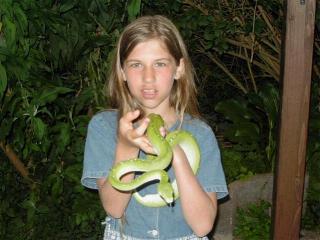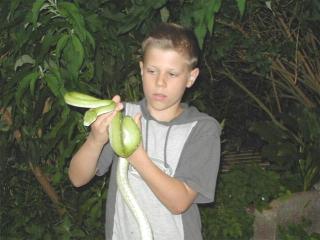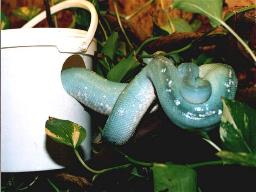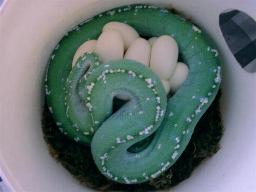 |
|||||||||
|
|
|||||||||
|
|
|||||||||
|
Copyright © since 2000 |
|||||||||
|
|
|||||||||
|
|
Morelia viridis |
||||
|
|
||||
|
The enclosure Due to the high air humidity my enclosures for Morelia vididis are made of glass. The sice of the enclosure for my three Aru ladies is 140 cm (length) – 60 cm (width) – 100 cm (heigth). The heating depends on ELKSTEIN’ emitters. We do not use a ground heating because the enclosure of the Morelia viridis stand on the other enclosures. The temperature is regulated over a thermostat (Thermo Timer) – within the day 30° Celsius and in the night its 23° Celsius. In the evening everything is sprayed and the ground material (peat and blowing clay) is kept wet to keep the humidity constantly high. Additionally this is strenghtened by planting. The lightning depends on neon tubes. |
 |
|||||
|
Photo HaraldQ |
|||||
|
Breeding: |
|||||
|
Morelia viridis is a mating-willing snake. It is all the same if you keep the males and females together the year over.In autumn if the night temperature goes down to 23° Celsius, and the females are in good condition, it will come to mating. Newertheless I keep the males and females separated the year over; I put the males to the females in September. Due to this way I prevent that the females produce a clutch of eggs several times a year. The females of Morelia viridis are really “guzzlers”, but incline to become fat. Within the summer months, when the temperature in the night drops down to 26° Celsius, you have to watch out if you handle inside the enclosure because they snatch against everything.This circumstance could be helpful because a certain fat portion is necessary for the follicle production and that a pregnantness could be expected. Now we feed the females that they get the correct substance. Starting from September on we reduce the lightning duration per week by one hour – from 12 up to 8 hours per day. I do no other activities. I made bad experience with a night-time temperate of 20°Celsius - my breed male got a pneumonia. In case of a fertilization in September or October the female stopped eating by the end of the year. Approximately in February or March it came to sheeding. Now the oviposition is approaching and a suitable box must be offered. For this I use a 5 litre bucket with a cover (in the cover is a hole of 5 centimeter). I hang the bucket in the branches. The bucket is filled with dry moss which I collected in the wood. Through extract by boiling it became sterilized. |
|
|
||||||||||||||||||||||||
|
After about 14 up to 28 days after the sheeding the eggs are set off. In this time the female stays several days long in the oviposition box. A few days before the oviposition the female creeps nerveous through the enclosure. This is a clear signal that the oviposition will start soon. |
|
Natural brood To the nature brood you put the female including the oviposition box into an enclosure with a humidity of minimum 90 percent and a constant temperature of 29° up to 31°Celsius. You have to pay attention that the eggs do not become wet. After approximately 50 up to 55 days the neonates slip out of the eggs. |
|
False Incubation I prefer the false / artificial incubation to preserve the female. As soon as the female puts the eggs into the moss I remove it very carefully. After that I transfer the eggs into the self constructed incubator which is a standard glass enclosure. The brood over will be with 31° Celsius and minimum 95 % air humidity. After approximately 50 up to 55 days the neonates slip out of the eggs.
My incubator is a standard commercial glass enclosure filled with a few centimeter water. At the ground is a heating cable (50 Watts) which is connected to a thermostat. I put the eggs on an alumium plate over the water. Over the clutch of eggs a glass plate have been installed to protect the eggs of dropping condensation. The ventilation was reduced to a minimum but not closed completely. The enclosure was covered with polystyrene. With this self constructed incubator I reached a slip rate of 100 %. |
|
Eggs after 40 days in the incubator |
|||||
|
Photo HaraldQ |
|||||
|
The breeding: The breeding / raising takes place in a plastic box with the size 23 centimeter (length) – 16 centimeter (width) – 17 centimeter (heigth). The box is filled with one centimeter water. As false branches I use plastic tubes with a rough survace from the electronic industry with a diameter of one centimeter. These little boxes will take place in a glass enclosure. The thermostat controlles the heating cable and allows a temperature of 31° Celsius within the day and 26° Celsius in the night. The humidity is strengthened by spraying in the evening. Weekly we feed one mouse according the size of the neonates. At the age of 6 months I move the animals in their final enclosure. More information of the breeding of little Morelia viridis you find at the page “breeding” (Aufzucht). |
|
|
||||||||||||||
|
Green tree pythons are not biting as usually accepted (excluding Biak form). The following pictures have been made during shifting the animals. However the impression is not to develop that animals would be suitable as toys for children. In principle I do not move the animals unnecessarily. |
 |
 |
||||||
|
Photos HaraldQ |
|||||||



